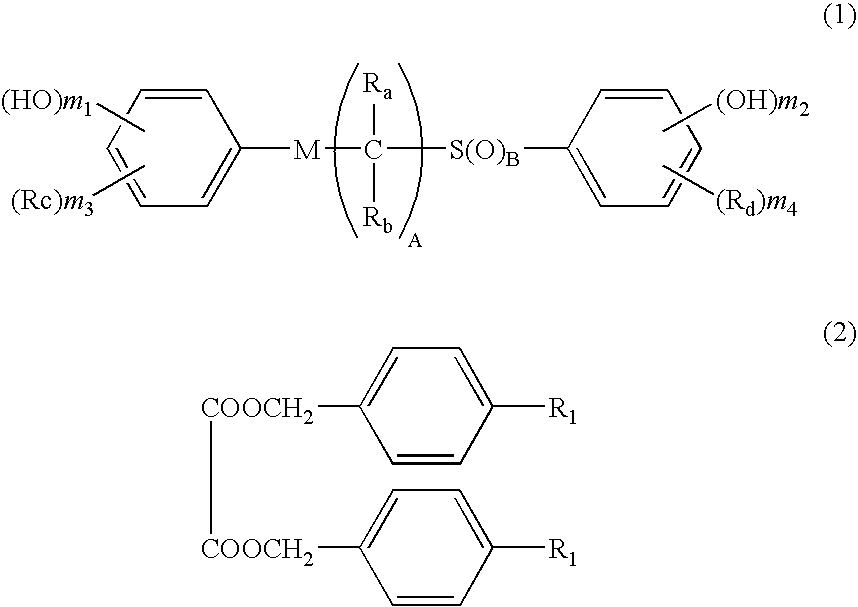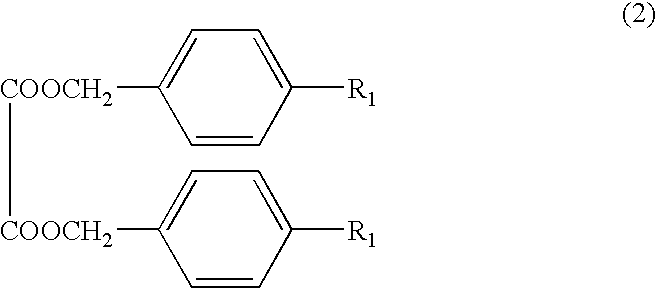Thermally sensitive recording medium
a recording medium and thermally sensitive technology, applied in thermography, duplicating/marking methods, instruments, etc., can solve the problems of color image fade, difficult to achieve both characteristics, and difficult to provide thermally sensitive recording medium with image stability to ligh
- Summary
- Abstract
- Description
- Claims
- Application Information
AI Technical Summary
Benefits of technology
Problems solved by technology
Method used
Image
Examples
example 1
[0157]Materials for a dye, color developing agent, and sensitizer were prepared into respective dispersion liquids having the following compositions. Each dispersion liquid was subjected to wet milling using a sand grinder to an average particle size of 0.5 μm.
[0158]
1:1 Mixture of N-(4′-hydroxyphenylthio)acetyl-4- 6.0 partshydroxyaniline and N-(4′-hydroxyphenylthio)acetyl-2-hydroxyaniline (trade name: D-100,available from Nippon Soda Co., Ltd.)10% Aqueous solution of polyvinyl alcohol18.8 partsWater11.2 parts3-Di-n-butylamino-6-methyl-7-anilinofluorane (OBD-2) 3.0 parts10% Aqueous solution of polyvinyl alcohol 6.9 partsWater 3.9 partsDi(p-chlorobenzyl)oxalate 6.0 parts10% Aqueous solution of polyvinyl alcohol18.8 partsWater11.2 parts
[0159]The dispersion liquids were mixed in the following ratio to prepare a composition as a coating liquid for a thermally sensitive recording layer. The coating liquid was coated and dried on a surface of a base paper having a basic weight of 80 g / m2 s...
example 2
[0161]A stabilizer dispersion liquid having the following composition was prepared, and the dispersion liquid was subjected to wet milling using a sand grinder to an average particle size of 0.5 μm.
[0162]
3-{[(Phenylamino)carbonyl]amino}benzenesulfonamide3.0 parts(SU-727)10% Aqueous solution of polyvinyl alcohol9.4 partsWater5.6 parts
[0163]The above-described stabilizer dispersion liquid was added to the dispersion liquids prepared in Example 1 in the following ratio and the following compositions were mixed, to thereby obtain a coating liquid for a thermally sensitive recording layer.
[0164]
Dispersion of color developing agent36.0 partsDye dispersion liquid13.8 partsSensitizer dispersion liquid36.0 partsStabilizer dispersion liquid 9.0 parts50% Dispersion liquid of kaolin clay26.0 parts30% Dispersion liquid of zinc stearate 6.7 parts
The coating liquid was coated and dried on a surface of a base paper having a basic weight of 80 g / m2 such that the coating amount after drying was 6 g / m...
example 3
[0165]A dispersion liquid containing a urea-urethane stabilizer (abbreviated as UU) represented by the following chemical formula (4) was prepared, and the dispersion liquid was subjected to wet milling using a sand grinder to an average particle size of 0.5 μm.
[0166]
(4)(UU)3.0 parts10% Aqueous solution of polyvinyl alcohol9.4 partsWater5.6 parts
[0167]The above-described stabilizer dispersion liquid was mixed into the dispersion liquids prepared in Example 1 in the following ratio, to thereby obtain a coating liquid for a thermally sensitive recording layer.
[0168]
Dispersion of color developing agent36.0 partsDye dispersion liquid13.8 partsSensitizer dispersion liquid36.0 partsStabilizer dispersion liquid 9.0 parts50% Dispersion liquid of kaolin clay26.0 parts30% Dispersion liquid of zinc stearate 6.7 parts
The coating liquid was coated and dried on a surface of a base paper having a basic weight of 80 g / m2 such that the coating amount after drying was 6 g / m2. The resultant coated pap...
PUM
| Property | Measurement | Unit |
|---|---|---|
| melting point | aaaaa | aaaaa |
| melting point | aaaaa | aaaaa |
| particle size | aaaaa | aaaaa |
Abstract
Description
Claims
Application Information
 Login to View More
Login to View More - R&D
- Intellectual Property
- Life Sciences
- Materials
- Tech Scout
- Unparalleled Data Quality
- Higher Quality Content
- 60% Fewer Hallucinations
Browse by: Latest US Patents, China's latest patents, Technical Efficacy Thesaurus, Application Domain, Technology Topic, Popular Technical Reports.
© 2025 PatSnap. All rights reserved.Legal|Privacy policy|Modern Slavery Act Transparency Statement|Sitemap|About US| Contact US: help@patsnap.com



